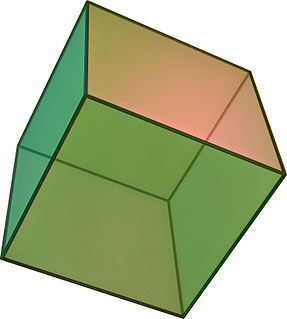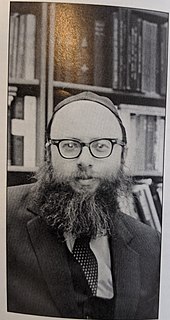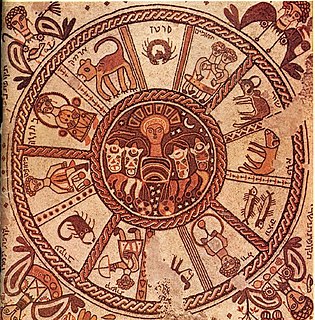Related Research Articles

In geometry, a cube is a three-dimensional solid object bounded by six square faces, facets or sides, with three meeting at each vertex.

In geometry, an octahedron is a polyhedron with eight faces. The term is most commonly used to refer to the regular octahedron, a Platonic solid composed of eight equilateral triangles, four of which meet at each vertex.

Aryeh Moshe Eliyahu Kaplan was an American Orthodox rabbi, author, and translator, best known for his Living Torah edition of the Torah. He became well known as a prolific writer and was lauded as an original thinker. His wide-ranging literary output, inclusive of introductory pamphlets on Jewish beliefs and philosophy written at the request of NCSY, is often regarded as a significant factor in the growth of the baal teshuva movement.
Sefer Yetzirah is the title of the earliest extant book on Jewish mysticism, although some early commentators treated it as a treatise on mathematical and linguistic theory as opposed to Kabbalah. Yetzirah is more literally translated as "Formation"; the word Briah is used for "Creation". The book is traditionally ascribed to the patriarch Abraham, although others attribute its writing to Rabbi Akiva. Modern scholars have not reached consensus on the question of its origins. According to Rabbi Saadia Gaon, the objective of the book's author was to convey in writing how the things of our universe came into existence. Conversely, Judah Halevi asserts that the main objective of the book, with its various examples, is to give to man the means by which he is able to understand the unity and omnipotence of God, which are multiform on one side and, yet, uniform on the other.
Bahir or Sefer HaBahir is an anonymous mystical work, attributed to a 1st-century rabbinic sage Nehunya ben HaKanah because it begins with the words, "R. Nehunya ben HaKanah said". It is also known as Midrash of Rabbi Nehunya ben HaKanahמִדְרָשׁ רַבִּי נְחוּנְיָא בֶּן הַקָּנָה.
The tzimtzum or tsimtsum is a term used in the Lurianic Kabbalah to explain Isaac Luria's doctrine that God began the process of creation by "contracting" his Ohr Ein Sof in order to allow for a "conceptual space" in which finite and seemingly independent realms could exist. This primordial initial contraction, forming a ḥālāl happānuy "vacant space" into which new creative light could beam, is denoted by general reference to the tzimtzum. In Kabbalistic interpretation, tzimtzum gives rise to the paradox of simultaneous divine presence and absence within the vacuum and resultant Creation.

Sefirot, meaning emanations, are the 10 attributes/emanations in Kabbalah, through which Ein Sof reveals itself and continuously creates both the physical realm and the chain of higher metaphysical realms. The term is alternatively transliterated into English as sephirot/sephiroth, singular sefirah/sephirah, etc.

Astrology has been a topic of debate among Jews for over 2000 years. While not a Jewish practice or teaching as such, astrology made its way into Jewish thought, as can be seen in the many references to it in the Talmud. Astrological statements became accepted and worthy of debate and discussion by Torah scholars. Opinions varied: some rabbis rejected the validity of astrology; others accepted its validity but forbid practicing it; still others thought its practice to be meaningful and permitted. In modern times, as science has rejected the validity of astrology, many Jewish thinkers have similarly rejected it; though some continue to defend the pro-astrology views that were common among pre-modern Jews.
The BOTA Tarot was created by Paul Foster Case, founder of Builders of the Adytum (BOTA), and artist Jessie Burns Parke. Although it is based upon, and for the most part closely resembles, Arthur Edward Waite's 1909 Rider-Waite deck, Case changed what he said were mistakes or "blinds" on the part of Waite. The BOTA Tarot is available as standard-sized full deck and a larger version containing only the Major Arcana are black and white, since Case believed that every student needed to color their own deck. After his death, the Major Arcana became also available in color. Each of these cards has a border of a particular color, which is the color that is associated with the card in the writings of Case.
Beri'ah, Briyah, or B'ri'ah, is the second of the four celestial worlds in the Tree of Life of the Kabbalah, intermediate between the World of Emanation (Atziluth) and the World of Formation (Yetzirah), the third world, that of the angels. It is known as the World of Creation, or Korsia.

Solomon Judah Löb HaKohen Rapoport was a Galician and Czech rabbi and Jewish scholar. Rapoport was known by an acronym "Shir", שי"ר occasionally שיל"ר, formed by the initial letters of his Hebrew name "Sh"elomo "Y"ehuda "R"apoport. Shir literally means "song" in Hebrew. He was one of the founders of the new Wissenschaft des Judentums movement.

Sefer Raziel HaMalakh,, is a grimoire of Practical Kabbalah from the Middle Ages written primarily in Hebrew and Aramaic. Liber Razielis Archangeli, its 13th-century Latin translation produced under Alfonso X of Castile, survives.

Barachiel is one of the Archangels in Judaism, as well as Byzantine Catholic and Eastern Orthodox tradition. He is the Archangel of Blessings.
The Scrolls of Abraham are a part of the religious scriptures of Islam. These scriptures are believed to have contained the revelations of Abraham received from God, which were written down by him as well as his scribes and followers.
Shem HaMephorash, meaning "the explicit name," is originally a Tannaitic term describing the Tetragrammaton. In Kabbalah, it may refer to a name of God composed of either 4, 12, 22, 42, or 72 letters, the latter version being the most common.
Jewish mystical exegesis is a method of interpreting the Bible based on the assumption that the Torah contains secret knowledge regarding creation and the manifestations of God. The only way to find these secrets is to know how to decode the text and reveal them. The method most likely dates back to the 3rd century.
The primary texts of Kabbalah were allegedly once part of an ongoing oral tradition. The written texts are obscure and difficult for readers who are unfamiliar with Jewish spirituality which assumes extensive knowledge of the Tanakh, Midrash and halakha.
Various numbers play a significant role in Jewish texts or practice. Some such numbers were used as mnemonics to help remember concepts, while other numbers were considered to have intrinsic significance or allusive meaning.
Sefer HaTemunah is a 13–14th century kabbalistic text. It is quoted in many Halakhic sources.
Yichudim is a specific form of Jewish meditation in Kabbalistic Jewish mysticism, especially denoting the complete meditative method developed by Isaac Luria (1534–1572). The term Yichud is found in Halakha, denoting male-female "seclusion". In the esoteric anthropomorphism in Kabbalah, Yichudim denote unifications between male and female Divine aspects in the supernal sephirot.
References
- 1 2 The Tarot, A Key to the Wisdom of the Ages by Case, Paul Foster
- ↑ Sefer Yetzirah The Book of Creation by Kaplan, Aryeh
- ↑ Sefer Yetzirah The Book of Creation, Page 203, by Kaplan, Aryeh
- ↑ The Cube of Space: Container of Creation by Townley, Kevin
- ↑ Meditations on the Cube of Space by Townley, Kevin